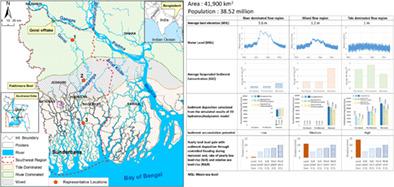当前位置:
X-MOL 学术
›
Hydrol. Process.
›
论文详情
Our official English website, www.x-mol.net, welcomes your
feedback! (Note: you will need to create a separate account there.)
Spatial and seasonal variability of sediment accumulation potential through controlled flooding of the beels located in the polders of the Ganges‐Brahmaputra‐Meghna delta of Southwest Bangladesh
Hydrological Processes ( IF 2.8 ) Pub Date : 2021-03-12 , DOI: 10.1002/hyp.14119 Md Feroz Islam 1 , Hans Middelkoop 2 , Paul P. Schot 1 , Stefan C. Dekker 1 , Jasper Griffioen 1, 3
Hydrological Processes ( IF 2.8 ) Pub Date : 2021-03-12 , DOI: 10.1002/hyp.14119 Md Feroz Islam 1 , Hans Middelkoop 2 , Paul P. Schot 1 , Stefan C. Dekker 1 , Jasper Griffioen 1, 3
Affiliation

|
The Ganges‐Brahmaputra‐Meghna (GBM) delta plain within Bangladesh is one of the most vulnerable to relative sea level rise (RSLR) in the world especially under current anthropogenically modified (i.e., embanked) conditions. Tidal river management (TRM) as practiced in coastal regions of Bangladesh may provide an opportunity to combat RSLR by raising the land level through controlled sedimentation inside beels (depression within embanked polders) with re‐opening of polders. To date, TRM has been applied to tide‐dominated coastal regions, but the potential applicability of TRM for the beels within the polders of river‐dominated and mixed flow (MF) regimes remains to be assessed. We apply a calibrated 2D numerical hydromorphodynamic model to quantify sediment deposition in a beel flooded through breaching of the polder dike under conditions of river‐dominated, tide‐dominated and MF regimes for different seasons and applying different regulation schemes for the flow into the beel. Simulation results show considerable seasonality in sediment deposition with largest deposition during the monsoon season. The potential of controlled flooding is highest in the tide‐dominated region, where sediment accumulation can be up to 28 times higher than in the river‐dominated region. Regulating flow into a beel increases trapping efficiency, but results in slightly lower total deposition than without regulation. We conclude that re‐establishing flooding of the beel within the polder without regulating the flow into the beel through breaching of the polder dike is a promising strategy for the mixed and tide‐dominated flow regions in the delta as the sediment accumulation can raise the land surface at a higher rate than RSLR and effective SLR (ESLR). In the more upstream river‐dominated section of the delta, accumulation rates would be much lower, but the pressure of sea level rise on these areas is lower as well. Owing to the abundant availability of sediment, application of controlled flooding like TRM therefore provides an opportunity to counteract the impact of RSLR and ESLR by means of land raising, particularly along the tidal river reaches in the GBM delta.
中文翻译:

通过控制西南孟加拉国恒河-布拉马普特拉-梅格纳河三角洲田中的Beels进行洪水淹没,沉积物沉积潜力的空间和季节变化
孟加拉国内的恒河-布拉马普特拉-梅格纳河(GBM)三角洲是世界上最容易受到相对海平面上升(RSLR)影响的地区之一,尤其是在当前人为调整(即堤防)条件下。孟加拉国沿海地区的潮汐河流管理(TRM)可能会提供一定的机会,通过重新打开be田,通过控制els内的沉积物(堤内的洼地)来提高土地高度,从而抗击RSLR。迄今为止,TRM已应用于潮汐为主的沿海地区,但是TRM在河床为主和混流(MF)体制的田中的海狸的潜在适用性仍有待评估。我们应用校准的2D数值水动力模型来量化在不同季节的河流主导,潮汐主导和MF体制下,通过突破di堤淹没的黄be中的沉积物,并对流入黄el的流量采用不同的调节方案。模拟结果表明,季风季节沉积物的沉积具有可观的季节性,沉积量最大。在潮汐为主的地区,受控洪水的潜力最高,那里的沉积物堆积可能是河流为主的地区的28倍之多。调节流入Beel的流量可提高捕集效率,但与不进行调节相比,其总沉积量略低。我们得出的结论是,对于三角洲内混流和潮汐为主的流域,在pol田内重新建立黄el泛滥而又不通过突破田堤来调节流入黄el的流量是一种有前途的策略,因为沉积物积聚可以增加土地面积表面比RSLR和有效SLR(ESLR)高。在三角洲上游地区,河流的蓄积率将大大降低,但这些地区的海平面上升压力也将降低。由于沉积物的丰富利用,因此像TRM这样的受控洪水的应用提供了机会,通过土地耕种,特别是GBM三角洲的潮汐河段,抵消了RSLR和ESLR的影响。
更新日期:2021-04-29
中文翻译:

通过控制西南孟加拉国恒河-布拉马普特拉-梅格纳河三角洲田中的Beels进行洪水淹没,沉积物沉积潜力的空间和季节变化
孟加拉国内的恒河-布拉马普特拉-梅格纳河(GBM)三角洲是世界上最容易受到相对海平面上升(RSLR)影响的地区之一,尤其是在当前人为调整(即堤防)条件下。孟加拉国沿海地区的潮汐河流管理(TRM)可能会提供一定的机会,通过重新打开be田,通过控制els内的沉积物(堤内的洼地)来提高土地高度,从而抗击RSLR。迄今为止,TRM已应用于潮汐为主的沿海地区,但是TRM在河床为主和混流(MF)体制的田中的海狸的潜在适用性仍有待评估。我们应用校准的2D数值水动力模型来量化在不同季节的河流主导,潮汐主导和MF体制下,通过突破di堤淹没的黄be中的沉积物,并对流入黄el的流量采用不同的调节方案。模拟结果表明,季风季节沉积物的沉积具有可观的季节性,沉积量最大。在潮汐为主的地区,受控洪水的潜力最高,那里的沉积物堆积可能是河流为主的地区的28倍之多。调节流入Beel的流量可提高捕集效率,但与不进行调节相比,其总沉积量略低。我们得出的结论是,对于三角洲内混流和潮汐为主的流域,在pol田内重新建立黄el泛滥而又不通过突破田堤来调节流入黄el的流量是一种有前途的策略,因为沉积物积聚可以增加土地面积表面比RSLR和有效SLR(ESLR)高。在三角洲上游地区,河流的蓄积率将大大降低,但这些地区的海平面上升压力也将降低。由于沉积物的丰富利用,因此像TRM这样的受控洪水的应用提供了机会,通过土地耕种,特别是GBM三角洲的潮汐河段,抵消了RSLR和ESLR的影响。











































 京公网安备 11010802027423号
京公网安备 11010802027423号